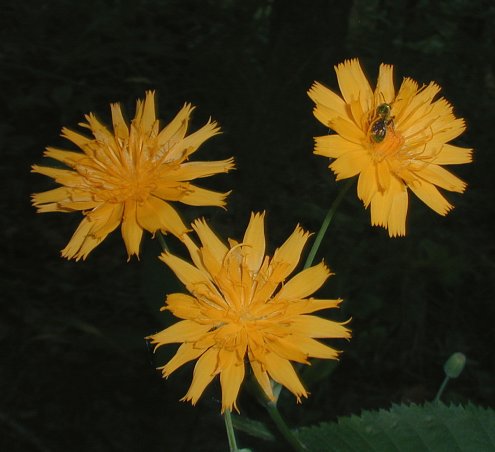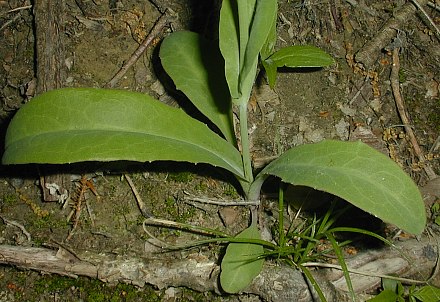Description: This perennial wildflower consists of a rosette of basal leaves, from which a flowering stalk about 1-2' tall is produced. The basal leaves are up to 7" long and 2" across; they are pale green to green, hairless, and oblanceolate or obovate in shape. Their margins are smooth, undulate, slightly dentate, or slightly pinnatifid. The flowering stalk is pale green, hairless, glaucous, terete, and erect. There are 1-2 cauline leaves on the flowering stalk that are ovate in shape and smooth or dentate along their margins. Where the uppermost cauline leaf occurs, the stalk branches into 2-5 ascending peduncles. Each peduncle terminates in a yellow or orange-yellow flowerhead about 1–1½" across. Each flowerhead has many spreading ray florets and no disk florets. Each ray floret is narrowly oblong and yellow or orange-yellow; it has a truncate tip with 5 small teeth. The base of the flowerhead is surrounded by several floral bracts in a single series; each bract is pale green, linear-lanceolate, hairless, glaucous, and about 1/3" (8 mm.) in length or a little longer. The blooming period can occur from late spring to mid-summer and lasts about a month. Later in the year, the ray florets are replaced by small achenes. Each achene is bullet-shaped and truncate at the apex, where it has a tuft of white hairs. The achenes are distributed by the wind. The root system consists of a thickened crown with fibrous roots.

Cultivation:
The
preference is partial or dappled sunlight and mesic to dry conditions.
Different kinds of soil are tolerated, including those containing loam,
clay-loam, sand, or rocky material. Water-logged sites should be
avoided.
Range & Habitat:
The native Two-Flowered Cynthia is occasional to locally common
throughout
Illinois (see Distribution
Map). Habitats include open upland woodlands, open sandy
woodlands, savannas and sandy savannas, rocky wooded slopes, thinly
wooded bluffs, areas along woodland paths, rocky glades, and upland
meadows. Two-Flowered Cynthia is often found in upland habitats where
Oaks are dominant in areas with thin leaf cover and sparse ground
vegetation.
Faunal Associations:
The flowerheads attract long-tongued bees (bumblebees, honeybees,
Little Carpenter bees, Cuckoo bees, Mason bees), short-tongued bees
(Halictid bees, Masked bees), predatory wasps, flies (Syrphid,
Tachinid, & others), butterflies, skippers, and beetles. These
insects suck nectar, collect pollen, or feed on pollen from the
flowerheads. An oligolectic visitor, Andrena krigiana
(Krigia Andrenid Bee), is specifically attracted to the flowerheads of Krigia
spp. In addition to these floral visitors, an aphid, Uroleucon brachychaetum,
sucks plant juices from these plants. Thus far, I have not observed any
evidence that
White-Tailed Deer feed on the foliage of Two-Flowered Cynthia, which
contains a bitter white latex, although I would not rule out this
possibility.

Photographic
Location:
The photographs were taken along the edge of two wooded bluffs in
Vermilion County, Illinois.
Comments:
The flowerheads and foliage of this wildflower are quite attractive.
Most members of the Aster family with dandelion-like flowerheads
(including other Krigia spp. in Illinois) have
yellow ray florets, but the ray florets of Two-Flowered Cynthia often
have an orange tint. Two-Flowered Cynthia has larger flowerheads (1"
across or more), longer floral bracts (1/3" or more), and its achenes
have more bristly hairs (20 or more) than either Krigia
virginica or Krigia caespitosa (both
annuals). Another species, Krigia dandelion (Potato
Dandelion) has unbranched flowering stalks that each produce a single
flowerhead. In contrast, Two-Flowered Cynthia has flowering stalks that
branch above their uppermost cauline leaves, each stalk producing 2-5
flowerheads on separate peduncles.